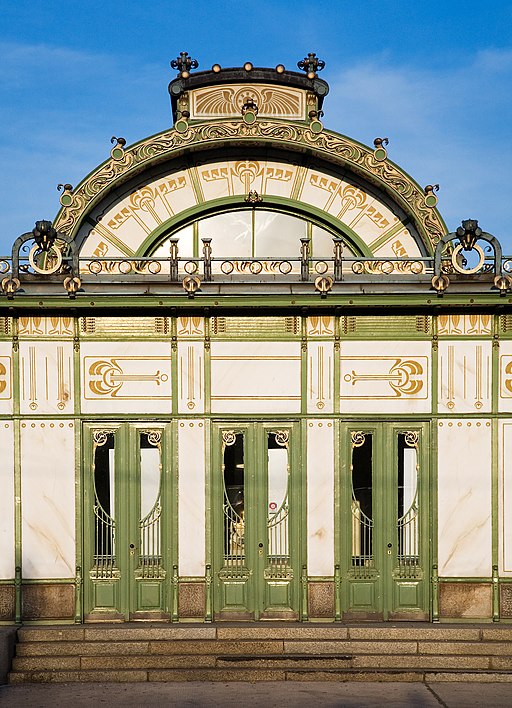Art Nouveau captured the accurate naturalism developed in the time following scientific advances such as those made by Darwin. Geographic variations may be most vividly exposed in reviewing the designs present in Vienna and Paris. Each retains the motive using materials including glass and metal. In Vienna, Otto Wagner (1841–1918) and Josef Hoffmann (1870–1956) captured it in symmetrical form and angular representations, contrasting with the Parisian style, where Hector Guimard (1867-1942) used forms that were highly stylised and represented an organic flow.
Guimard’s Castel Béranger encapsulates the naturalistic form displayed in the Parisian manifestation of Art Deco. What we see is the geometry of nature. Stylised organic forms integrate abstraction to project a naturalistic version of the industrial process and modern materials. We see a morphed version of the classical Grecian styles as they are merged into both Egyptian elements and the lotus flower.
It is a style that projects modernity and the tensions of the military build-up happening throughout Europe. In the USSR, we see the metro stations reflecting an ultra-modern view of a futuristic society that never developed. They compare well with the Chrysler Building, while contrasting with the more naturalistic forms of Gaudí’s Casa Batlló. Stylistically, there is a combination of primitive African art mixed into the symbolic nature of Catalonian roots, referencing nature and dragons.
The geographic location and form match the spirit exhibited by the people, with Glasgow best represented by, “Oh ye, all ye that walk in Willowwood” (Margaret MacDonald MacKintosh, 1903). We see each region using the modern materials, yet capturing the heart of its mythical past.
Art Deco saw the introduction of speed and power. With trains and automobiles and the telephone, both transport and communications had changed and revolutionised the world. Combined with the scientific advances made by Darwin in the nineteenth century and with the psychoanalytical theories of Freud, Art Deco allowed the artist to create a system that merged nature and society.
Yet, as Europe embraced an organic reality, the United States went more towards the angular. We see the embellishments of primitive cultures with the Mesoamerican sculptural relief of the Aztec or Mayan ziggurat, perched on top of the Paramount Building and reflected in the Chrysler Building. There is a strong Greco-Roman element in the entrance to the Rockefeller Centre. The geometric ornamentation and mosaics modernise the Romantic and merge it into the Roman, while adding a touch of Egyptian mystic and African paganism.
Futuristic art movements including Fauvism, Cubism, and Bauhaus were born out of the imagination inspired by a system that merged the old and the new, the ancient and the future. While Europe embraced the naturalistic organic flow, as best exhibited in architectural works by Gaudí, the United States can be best envisioned in Lalique’s ‘Spirit of the Wind’ (1925).
Such a symbol of power and movement simultaneously captures an Egyptian past and moves into the future, becoming a hood ornament power motion and forward momentum. We see both the spirit of the wind rushing past the vehicle and the past that was running behind.
The renovation by Gaudí (1904-6) of the urban townhouse Casa Batlló demonstrates the use of modern materials in the development of an elfin fairyland. The Catalonian nationalist history and eclectic mix of concepts and materials, integrating stone and wrought iron, wood, and plaster, all crafted to the highest level, encapsulates a dreamlike state of an organic, living system. The design is one that appears to have been grown rather than built. The renovation of the formally austere building, designed in 1877 by Emilio Sala Cortés (Antoni Gaudí’s architectural professor), allowed the student to take a basic building and demonstrate how he could infuse late aspects and create a work of imagination and creativity.
Villa Savoye by the Swiss architect Le Corbusier and his cousin Pierre Jeanneret (1928-31) represents the origins of modern architectural design, and encapsulates the international style. The five aspects developed by Le Corbusier include the replacement of supporting walls with rigid concrete columns, free standing ground plans with the absence of supporting walls, the free design of the façade, horizontal window designs that cut the façade across the entire length, lighting all rooms equally, and roof gardens, where a flat roof serves a domestic purpose.
The work by Gaudí may be seen to encapsulate a fantasy view of organic growth, whereas Le Corbusier stimulates the aesthetics of an ocean liner and industrialised modernity. In each case, the requirements of the occupants are superseded by the design principles of the architect. For Gaudí, the end was the design of an organic, seemingly living structure, whereas for Le Corbusier, it was the embodiment of his five design principles, dominated by the colour white.
[Image source: Otto Wagner Karlsplatz Stadtbahn Station, Vienna (1894-1902), © Jorge Royan / http://www.royan.com.ar]

